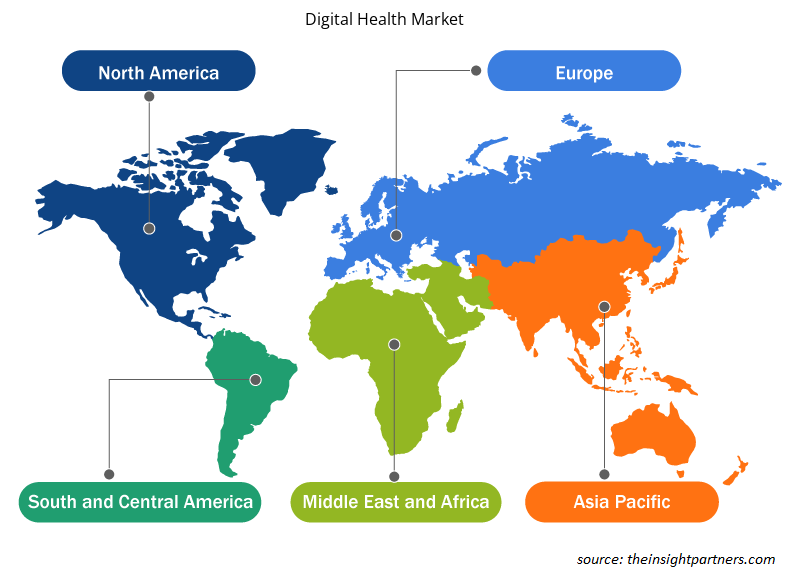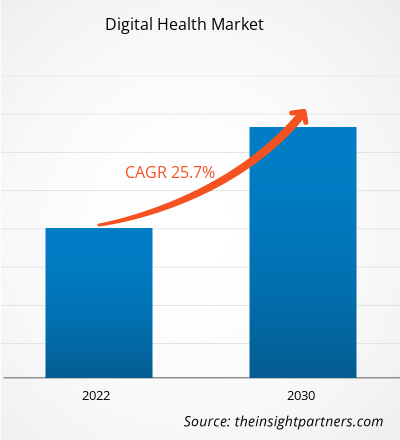[調査レポート] デジタルヘルス市場は、2022年の306,443.04百万米ドルから2030年には1,909,524.56百万米ドルに成長すると予想されており、2022年から2030年にかけて市場は25.7%のCAGRを記録すると予測されています。
アナリストの視点:
デジタル ヘルス市場の予測は、この市場の関係者が成長戦略を計画するのに役立ちます。デジタル ヘルス市場の成長要因には、インターネット接続とスマート デバイスの普及の増加、政府の規制サポートと政策イニシアチブの増加、医療 IT インフラストラクチャの技術開発などがありますが、これらはデジタル ヘルス市場の成長を促進します。ただし、データとプライバシーの侵害に関連する安全性の懸念が市場の成長を妨げています。
デジタルヘルスとは、ヘルスケア業界の情報通信技術を利用して慢性疾患を遠隔管理することです。デジタルヘルス市場には、モバイルヘルス(mHealth)、ウェアラブルデバイス、遠隔医療、医療情報技術(IT)、カスタマイズ医療が含まれます。生命を脅かす疾患の早期発見や慢性疾患の管理など、さまざまなサービスを消費者に提供します。デジタルヘルスが提供するメリットは、デジタルヘルス市場の規模にプラスの影響を与えるでしょう。
市場洞察:
政府の規制支援と政策イニシアチブの強化がデジタルヘルス市場の成長を促進
規制支援と政府の取り組みは、デジタルヘルスの形成と推進に不可欠です。これらの取り組みには、デジタルヘルスソリューションの採用、統合、有効性を改善するためのさまざまなポリシー、規制、資金調達メカニズム、戦略的取り組みが含まれます。たとえば、米国国際開発庁(USAID)は、デジタルテクノロジーを活用して個人が重要な情報やサービスにアクセスできるようにし、健康で豊かな生活につながることを構想しています。同庁は、パートナー国の健康プログラムをサポートするデジタルテクノロジーへの投資を指示する専用の政策ガイドライン「デジタルヘルスにおける行動ビジョン」を策定しました。同様に、インド政府は2022年に、デジタルヘルスエコシステムを構築するためのAyushman Bharat Digital Health Mission(ABDM)を立ち上げました。同様に、2021年10月、フランス政府は国家のデジタルヘルスインフラストラクチャを強化するために6億5,000万ドル以上を投資しました。
さらに、世界保健機関 (WHO) は、国家e-Health戦略またはデジタル ヘルス ツールキットで、デジタル ヘルスを「健康への情報通信技術 (ICT) の応用」と定義しています。WHO によると、2020 年には、対象となるプロバイダーの 75% 以上と対象となる病院の 90% 以上が、病院が患者に健康情報を表示、ダウンロード、送信できるようにすることを奨励する政府プログラムに参加するための資金を受け取りました。2020 年 5 月、米国連邦政府は、医療提供者による EHR の使用を義務付ける連邦医療 IT 戦略計画 2020-2025 を提案しました。
したがって、上記の要因はデジタルヘルス市場シェアの拡大を促進するだろう。
要件に合わせてレポートをカスタマイズする
このレポートの一部、国レベルの分析、Excelデータパックなど、あらゆるレポートを無料でカスタマイズできます。また、スタートアップや大学向けのお得なオファーや割引もご利用いただけます。
- このレポートの主要な市場動向を入手してください。この無料サンプルには、市場動向から見積もりや予測に至るまでのデータ分析が含まれます。
レポートのセグメンテーションと範囲:
「デジタルヘルス市場分析」は、提供内容、テクノロジー、アプリケーション、エンドユーザーというセグメントを考慮して実施されました。
の世界のデジタルヘルス市場は、提供内容に基づいてセグメント化されています。テクノロジー、応用、エンドユーザーと地理。デジタルヘルス市場は、提供内容によって、ソフトウェア、サービス、ハードウェアに分類されます。デジタルヘルス市場は、技術別に、mHealth、遠隔医療、デジタルヘルスシステム、その他に分類されます。デジタルヘルス市場は、アプリケーション別に、慢性疾患管理、行動健康、健康とフィットネスなど。デジタルヘルス市場は、エンドユーザー別に、病院と診療所、患者と消費者、その他に分類されています。病院と診療所がデジタルヘルス市場で最大のシェアを占めています。
地理的に見ると、世界のデジタルヘルス市場レポートは、北米(米国、カナダ、メキシコ)、ヨーロッパ(ドイツ、フランス、イタリア、英国、スペイン、その他のヨーロッパ)、アジア太平洋(中国、日本、インド、オーストラリア、韓国、その他のアジア太平洋)、中東およびアフリカ(南アフリカ、サウジアラビア、UAE、その他の中東およびアフリカ)、南米および中米(ブラジル、アルゼンチン、その他の南米および中米)に分類されています。
オファリングベースのインサイト
デジタルヘルス市場は、提供内容に基づいて以下のように分類されます。ソフトウェア、サービス、ハードウェア。サービス部門は2022年に最大の市場シェアを占め、2022年から2030年にかけて最高のCAGRを記録すると予想されています。
テクノロジーに基づく洞察
デジタルヘルス市場は、技術別に、mHealth、遠隔医療、デジタルヘルスシステム、その他に分類されています。mHealthセグメントは2022年に最大の市場シェアを占めました。遠隔医療セグメントは、2022年から2030年にかけて最も急速に成長すると予想されています。
アプリケーションベースの洞察
デジタルヘルス市場は、用途別に、慢性疾患管理、行動健康、健康とフィットネス、その他に分類されています。2022年には、慢性疾患管理セグメントが最大の市場シェアを占めました。
エンドユーザーベースの洞察
エンドユーザーに基づいて、デジタルヘルス市場は、病院と診療所、患者と消費者、その他に分類されます。病院・診療所部門は2022年に最大の市場シェアを占めました。
地域分析:
地理に基づいて、世界のデジタルヘルス市場は、アジア太平洋、ヨーロッパ、中東およびアフリカ、北米、南米および中米に分類されます。2022年には北米が世界市場で最大のシェアを占めました。アジア太平洋地域は2022年から2030年にかけて最高のCAGRを記録すると予想されています。
北米のデジタルヘルス市場は、米国、カナダ、メキシコに分かれています。デジタル ヘルスケアの変革と、モバイルアプリ、スマートウェアラブル、EHRや遠隔医療サービスなどのeHealthサービスなど、さまざまなテクノロジーを含むスマートヘルスケアソリューションの採用の増加が、主に市場を牽引しています。ヘルスケアにおける高度なソフトウェアテクノロジーの導入、病院数の増加、戦略的な政府政策の実施などの他の要因も、デジタルヘルス市場の促進に貢献しています。
米国は、北米および世界のデジタルヘルス市場への最大の貢献国です。2020年9月、米国食品医薬品局(FDA)はデジタルヘルスセンターオブエクセレンスを立ち上げました。この設立は、デジタルヘルス技術の進歩を促進するという同局の取り組みに向けた重要な動きです。これには、モバイルヘルスデバイス、 医療機器としてのソフトウェア(SaMD)、医療機器として使用されるウェアラブル、医療製品の研究に利用されるテクノロジーが含まれます。さらに、国内の大手市場プレーヤーの存在とその開発は、市場の成長に有利に働く可能性があります。
デジタルヘルス市場の地域別洞察
予測期間を通じてデジタルヘルス市場に影響を与える地域的な傾向と要因は、Insight Partners のアナリストによって徹底的に説明されています。このセクションでは、北米、ヨーロッパ、アジア太平洋、中東およびアフリカ、南米および中米にわたるデジタルヘルス市場のセグメントと地理についても説明します。

- デジタルヘルス市場の地域別データを入手
デジタルヘルス市場レポートの範囲
| レポート属性 | 詳細 |
|---|---|
| 2022年の市場規模 | 306,443.04百万米ドル |
| 2030年までの市場規模 | 1,909,524.56百万米ドル |
| 世界のCAGR(2022年 - 2030年) | 25.7% |
| 履歴データ | 2020-2022 |
| 予測期間 | 2022-2030 |
| 対象セグメント | 提供することで
|
| 対象地域と国 | 北米
|
| 市場リーダーと主要企業プロフィール |
|
デジタルヘルス市場のプレーヤー密度:ビジネスダイナミクスへの影響を理解する
デジタルヘルス市場は、消費者の嗜好の変化、技術の進歩、製品の利点に対する認識の高まりなどの要因により、エンドユーザーの需要が高まり、急速に成長しています。需要が高まるにつれて、企業は提供内容を拡大し、消費者のニーズを満たすために革新を起こし、新たなトレンドを活用し、市場の成長をさらに促進しています。
市場プレーヤー密度とは、特定の市場または業界内で活動している企業または会社の分布を指します。これは、特定の市場スペースに、その市場規模または総市場価値に対してどれだけの競合相手 (市場プレーヤー) が存在するかを示します。
デジタルヘルス市場で事業を展開している主要企業は次のとおりです。
- セルナーコーポレーション
- エクリニカルワークス
- Allscripts ヘルスケア ソリューションズ株式会社
- ハネウェルインターナショナル株式会社
- シスコシステムズ
免責事項:上記の企業は、特定の順序でランク付けされていません。

- デジタルヘルス市場のトップキープレーヤーの概要を入手
業界の発展と将来の機会:
- 2022年10月、メデュランスはリライアンス・ジオと提携して5G救急車を発売した。この車両にはスマートデバイスとカメラが搭載されており、双方向の音声・ビデオ通信、HD映像の伝送、位置追跡、高速インターネットネットワークを介して遠隔地の医師に患者の健康データをリアルタイムでストリーミングする機能を備えている。
- 2021年6月、AmazonはデジタルヘルスアクセラレーターであるAWS Healthcare Acceleratorを立ち上げ、ヘルスケアのバーチャルケアおよび分析分野のスタートアップ企業を支援しました。このプログラムでは、遠隔患者モニタリング、データ分析、患者エンゲージメント、音声テクノロジー、バーチャルケアを優先しています。
- 2021 年 10 月、デロイトとボーダフォンは、ボーダフォン ヘルス センター with デロイトを通じてヨーロッパ全土でヘルスケアへのアクセスを拡大するための戦略的提携を発表しました。このコラボレーションは、コネクテッド ヘルスケアの導入を加速することを目的としています。この仮想センターは、ボーダフォンのコネクテッド ヘルス ソリューションとデロイトのヘルスケア コンサルティングの専門知識を統合し、いつ、どこで必要な場合でも、個人がヘルスケアをより利用しやすくなります。
Cerner Corporation、Eclinicalworks、Allscripts Healthcare Solutions Inc.、Honeywell International Inc.、Cisco Systems、GE Healthcare、Koninklijke Philips NV、Siemens Healthineers AG、Qualcomm Technologies, Inc.、および Fitbit, Inc. は、デジタル ヘルス市場レポートで紹介されている著名な企業の一部です。これらの大手企業は、デジタル ヘルス市場におけるビジネス チャンスを活用し、市場での存在感と顧客層の拡大と多様化に重点を置いています。
- 過去2年間の分析、基準年、CAGRによる予測(7年間)
- PEST分析とSWOT分析
- 市場規模価値/数量 - 世界、地域、国
- 業界と競争環境
- Excel データセット


- Frozen Potato Market
- Glycomics Market
- Wheat Protein Market
- Mesotherapy Market
- Excimer & Femtosecond Ophthalmic Lasers Market
- Artificial Intelligence in Defense Market
- Quantitative Structure-Activity Relationship (QSAR) Market
- Hydrogen Storage Alloys Market
- Railway Braking System Market
- Playout Solutions Market

Report Coverage
Revenue forecast, Company Analysis, Industry landscape, Growth factors, and Trends

Segment Covered
This text is related
to segments covered.

Regional Scope
North America, Europe, Asia Pacific, Middle East & Africa, South & Central America

Country Scope
This text is related
to country scope.
よくある質問
Digital health refers to the implementation of digital technologies in the healthcare industry, including software, hardware, and related services. Several technologies fall under the umbrella of digital health, such as mobile health (mHealth) apps, wearable devices, electronic health records (EHRs), electronic medical records (EMRs), telemedicine, telehealth, and personalized medicine, among others.
The digital health market majorly consists of the players, including Cerner Corporation, Eclinicalworks, Allscripts Healthcare Solutions Inc., Honeywell International Inc., Cisco Systems, General Electric Company, Koninklijke Philips N.V., Siemens Healthineers AG, Qualcomm Technologies, Inc., Fitbit, Inc.
Key factors driving the growth of the digital health market are increasing internet connectivity and smart device penetration, rising government regulatory support and policy initiatives, and technological development in healthcare IT infrastructure.
The digital health market, by end-user, is segmented into hospitals & clinics, patients & consumers, and others. In 2022, the hospitals & clinics segment held the largest market share.
The digital health market was valued at US$ 306,443.04 billion in 2022.
The digital health market, by technology, is segmented into antibacterial drugs, antiviral drugs, antifungal drugs, and others. The mHealth segment held a larger market share in 2022. However, telehealthcare segment is anticipated to register a higher CAGR during 2022-2030.
Trends and growth analysis reports related to Technology, Media and Telecommunications : READ MORE..
The List of Companies - Digital Health Market
- Cerner Corporation
- Eclinicalworks
- Allscripts Healthcare Solutions Inc.
- Honeywell International Inc.
- Cisco Systems
- GE Healthcare
- Koninklijke Philips N.V.
- Siemens Healthineers AG
- Qualcomm Technologies, Inc.
- Fitbit, Inc.
The Insight Partners performs research in 4 major stages: Data Collection & Secondary Research, Primary Research, Data Analysis and Data Triangulation & Final Review.
- Data Collection and Secondary Research:
As a market research and consulting firm operating from a decade, we have published and advised several client across the globe. First step for any study will start with an assessment of currently available data and insights from existing reports. Further, historical and current market information is collected from Investor Presentations, Annual Reports, SEC Filings, etc., and other information related to company’s performance and market positioning are gathered from Paid Databases (Factiva, Hoovers, and Reuters) and various other publications available in public domain.
Several associations trade associates, technical forums, institutes, societies and organization are accessed to gain technical as well as market related insights through their publications such as research papers, blogs and press releases related to the studies are referred to get cues about the market. Further, white papers, journals, magazines, and other news articles published in last 3 years are scrutinized and analyzed to understand the current market trends.
- Primary Research:
The primarily interview analysis comprise of data obtained from industry participants interview and answers to survey questions gathered by in-house primary team.
For primary research, interviews are conducted with industry experts/CEOs/Marketing Managers/VPs/Subject Matter Experts from both demand and supply side to get a 360-degree view of the market. The primary team conducts several interviews based on the complexity of the markets to understand the various market trends and dynamics which makes research more credible and precise.
A typical research interview fulfils the following functions:
- Provides first-hand information on the market size, market trends, growth trends, competitive landscape, and outlook
- Validates and strengthens in-house secondary research findings
- Develops the analysis team’s expertise and market understanding
Primary research involves email interactions and telephone interviews for each market, category, segment, and sub-segment across geographies. The participants who typically take part in such a process include, but are not limited to:
- Industry participants: VPs, business development managers, market intelligence managers and national sales managers
- Outside experts: Valuation experts, research analysts and key opinion leaders specializing in the electronics and semiconductor industry.
Below is the breakup of our primary respondents by company, designation, and region:

Once we receive the confirmation from primary research sources or primary respondents, we finalize the base year market estimation and forecast the data as per the macroeconomic and microeconomic factors assessed during data collection.
- Data Analysis:
Once data is validated through both secondary as well as primary respondents, we finalize the market estimations by hypothesis formulation and factor analysis at regional and country level.
- Macro-Economic Factor Analysis:
We analyse macroeconomic indicators such the gross domestic product (GDP), increase in the demand for goods and services across industries, technological advancement, regional economic growth, governmental policies, the influence of COVID-19, PEST analysis, and other aspects. This analysis aids in setting benchmarks for various nations/regions and approximating market splits. Additionally, the general trend of the aforementioned components aid in determining the market's development possibilities.
- Country Level Data:
Various factors that are especially aligned to the country are taken into account to determine the market size for a certain area and country, including the presence of vendors, such as headquarters and offices, the country's GDP, demand patterns, and industry growth. To comprehend the market dynamics for the nation, a number of growth variables, inhibitors, application areas, and current market trends are researched. The aforementioned elements aid in determining the country's overall market's growth potential.
- Company Profile:
The “Table of Contents” is formulated by listing and analyzing more than 25 - 30 companies operating in the market ecosystem across geographies. However, we profile only 10 companies as a standard practice in our syndicate reports. These 10 companies comprise leading, emerging, and regional players. Nonetheless, our analysis is not restricted to the 10 listed companies, we also analyze other companies present in the market to develop a holistic view and understand the prevailing trends. The “Company Profiles” section in the report covers key facts, business description, products & services, financial information, SWOT analysis, and key developments. The financial information presented is extracted from the annual reports and official documents of the publicly listed companies. Upon collecting the information for the sections of respective companies, we verify them via various primary sources and then compile the data in respective company profiles. The company level information helps us in deriving the base number as well as in forecasting the market size.
- Developing Base Number:
Aggregation of sales statistics (2020-2022) and macro-economic factor, and other secondary and primary research insights are utilized to arrive at base number and related market shares for 2022. The data gaps are identified in this step and relevant market data is analyzed, collected from paid primary interviews or databases. On finalizing the base year market size, forecasts are developed on the basis of macro-economic, industry and market growth factors and company level analysis.
- Data Triangulation and Final Review:
The market findings and base year market size calculations are validated from supply as well as demand side. Demand side validations are based on macro-economic factor analysis and benchmarks for respective regions and countries. In case of supply side validations, revenues of major companies are estimated (in case not available) based on industry benchmark, approximate number of employees, product portfolio, and primary interviews revenues are gathered. Further revenue from target product/service segment is assessed to avoid overshooting of market statistics. In case of heavy deviations between supply and demand side values, all thes steps are repeated to achieve synchronization.
We follow an iterative model, wherein we share our research findings with Subject Matter Experts (SME’s) and Key Opinion Leaders (KOLs) until consensus view of the market is not formulated – this model negates any drastic deviation in the opinions of experts. Only validated and universally acceptable research findings are quoted in our reports.
We have important check points that we use to validate our research findings – which we call – data triangulation, where we validate the information, we generate from secondary sources with primary interviews and then we re-validate with our internal data bases and Subject matter experts. This comprehensive model enables us to deliver high quality, reliable data in shortest possible time.


 このレポートの無料サンプルを入手する
このレポートの無料サンプルを入手する